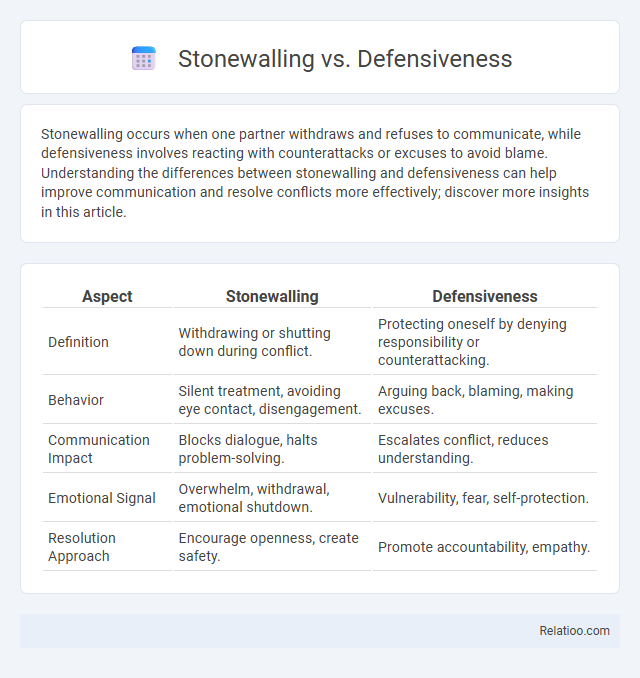Stonewalling occurs when one partner withdraws and refuses to communicate, while defensiveness involves reacting with counterattacks or excuses to avoid blame. Understanding the differences between stonewalling and defensiveness can help improve communication and resolve conflicts more effectively; discover more insights in this article.
Table of Comparison
| Aspect | Stonewalling | Defensiveness |
|---|---|---|
| Definition | Withdrawing or shutting down during conflict. | Protecting oneself by denying responsibility or counterattacking. |
| Behavior | Silent treatment, avoiding eye contact, disengagement. | Arguing back, blaming, making excuses. |
| Communication Impact | Blocks dialogue, halts problem-solving. | Escalates conflict, reduces understanding. |
| Emotional Signal | Overwhelm, withdrawal, emotional shutdown. | Vulnerability, fear, self-protection. |
| Resolution Approach | Encourage openness, create safety. | Promote accountability, empathy. |
Understanding Stonewalling and Defensiveness
Stonewalling involves withdrawing from communication and refusing to engage, often manifesting as silence or avoidance during conflicts. Defensiveness occurs when a person responds to perceived attacks with counter-arguments, blaming, or excuse-making, which escalates tension. Recognizing these behaviors in relationships helps address underlying issues by fostering open dialogue and emotional responsiveness to break negative interaction cycles.
Key Differences Between Stonewalling and Defensiveness
Stonewalling involves withdrawing or shutting down communication during conflicts, creating emotional distance and silence, while defensiveness is characterized by self-protective responses such as blaming or denying responsibility to avoid criticism. Your ability to recognize that stonewalling is a passive form of emotional avoidance, whereas defensiveness is an active reaction to perceived attacks, is crucial for improving communication. Understanding these key differences helps you address conflict more effectively by fostering openness instead of emotional walls or defensive barriers.
Psychological Roots of Stonewalling
Stonewalling arises from psychological roots such as emotional overwhelm and a fear of vulnerability, often linked to unresolved childhood trauma or attachment issues. Unlike defensiveness, which is a reactive attempt to protect oneself from perceived criticism, stonewalling involves emotional withdrawal as a coping mechanism to avoid conflict. Persistent stonewalling can severely impair communication and is associated with increased relationship dissatisfaction and stress.
Causes and Triggers of Defensiveness
Defensiveness often stems from perceived criticism, threats to self-esteem, or unresolved past conflicts, triggering protective reactions such as denial or counterattacks. Causes include feeling misunderstood, fear of vulnerability, or anticipation of blame during disagreements. Recognizing these triggers is essential to reducing defensive behavior and promoting healthier communication.
How Stonewalling Impacts Relationships
Stonewalling creates emotional distance by shutting down communication and refusing to engage, which can erode trust and intimacy in relationships. This behavior often leads to increased frustration and resentment, making conflict resolution nearly impossible. Understanding how your stonewalling affects relational dynamics is crucial for rebuilding connection and fostering healthier interactions.
The Effects of Defensiveness on Communication
Defensiveness during communication often triggers a breakdown in understanding by creating barriers to open dialogue and fostering resentment. When you display defensiveness, it can escalate conflicts, reduce empathy, and hinder problem-solving efforts within relationships. Recognizing and managing defensiveness is crucial to maintaining clear, effective, and respectful interactions.
Recognizing the Signs: Stonewalling vs Defensiveness
Recognizing the signs of stonewalling versus defensiveness involves understanding distinct behavioral patterns in communication. Stonewalling manifests as emotional withdrawal, silence, and refusal to engage, creating a barrier that halts productive conversation. Defensiveness, on the other hand, is characterized by rebuttals, counterattacks, and justification, signaling a protective reaction to perceived criticism--Your awareness of these differences can help navigate conflicts more effectively.
Strategies to Overcome Stonewalling
Stonewalling, characterized by emotional withdrawal and refusal to communicate, can be addressed through strategies such as taking self-soothing breaks, practicing active listening, and fostering a safe emotional environment. Unlike defensiveness, which involves protecting oneself through blame or justification, overcoming stonewalling requires intentional efforts to re-engage and express feelings constructively. Consistent use of calming techniques and open dialogue promotes trust and reduces the likelihood of communication breakdowns.
Effective Approaches to Reduce Defensiveness
Effective approaches to reduce defensiveness in interpersonal communication include practicing active listening, maintaining open body language, and fostering a non-judgmental environment that encourages vulnerability. Techniques such as using "I" statements to express feelings and needs without blame can significantly lower defensive reactions. Cultivating emotional awareness and self-regulation also helps individuals respond thoughtfully rather than react impulsively, thereby minimizing stonewalling behaviors.
Building Healthy Communication Habits
Stonewalling involves withdrawing from interaction, signaling emotional shutdown, while defensiveness manifests as self-protection through blame or denial, both undermining effective communication. Recognizing these behaviors enables partners to replace them with openness and active listening, fostering trust and emotional safety. Building healthy communication habits requires mutual accountability, empathy, and the willingness to address conflicts without resorting to stonewalling or defensiveness.

Infographic: Stonewalling vs Defensiveness
 relatioo.com
relatioo.com